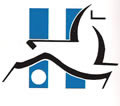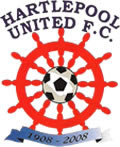Hartlepool
In 1881, West Hartlepool AFC was formed; they joined the Northern League around 1900 and went on to win the FA Amateur Cup in 1905.
In 1886, the West Hartlepool Rugby Club was founded and they built what became known as the Victoria Stadium in an old limestone quarry. When this club folded in 1908 a new limited company was formed to take over the ground and field a professional association football club. Despite being located in West Hartlepool, and over the objections of the incumbent amateur club, the new outfit took the name of Hartlepools United, representing the twin towns of Hartlepool and West Hartlepool. For a short period the two clubs co-existed and even shared the same ground until 1910 when West Hartlepool AFC was wound up and their assets passed to the professional club.
Hartlepools United acquired the unusual nickname of “The Monkey Hangers” after a grisly story from the Napoleonic Wars of the early 19th century. Legend has it that a French vessel foundered in a storm off the Hartlepool coast, the only survivor being a monkey, washed up on shore and found by local fishermen. Unfamiliar with what a French sailor might look like and unable to communicate with it, the fishermen hung the unfortunate beast from the mast of one of their boats as a spy. Today, the club has a monkey as its mascot.
During the First World War, the Victoria Ground was twice damaged by enemy action, the first a naval bombardment and later on by zeppelin raid, causing the club to build a temporary wooden stand. For many years afterwards, the board pursued a claim for damages against the German government without success.
In 1921, having finished in the top half of the North Eastern League, “Pools” were invited to join the Football League’s new Northern Section of the Third Division. During the close season a Workington player was transferred to the club in exchange for £10 and a box of kippers.
Prior to the outbreak of the Second World War the team made little impression and were forced to seek re-election on three occasions. During the late 1940s and throughout the 1950s there was still little for the fans to cheer about although they did enjoy some stirring FA Cup ties, most notable of which was a narrow 3-4 defeat by Manchester United’s “Busby Babes” in 1957.
During the late 1940s and throughout the 1950s there was still little for the fans to cheer about although they did enjoy some stirring FA Cup ties, most notable of which was a narrow 3-4 defeat by Manchester United’s “Busby Babes” in 1957.
The first time that a crest appeared on 'Pools' shirts was the 1959-60 season when a simple shield bearing the club's initials was worn on the white shirts that season. This was dropped in January 1959 or thereabouts when a new set of blue and striped shirts were adopted.
That Pools survived the early 1960s is something of a miracle, as they applied for re-election on five successive occasions between 1960 and 1964. They were rescued by the young Brian Clough who, as manager, brought in Peter Taylor from Burton Albion as his assistant. Clough famously visited every pub in the two towns to raise money (and, no doubt enjoying a few free pints on the way.) Before Clough and Taylor went on to make history at Derby County and later Nottingham Forest, they built a side that won promotion for the first time in 1968.
In August of 1968 the twin towns were amalgamated and to mark the occasion the club changed its name to Hartlepool FC. They could not survive in the higher level, however, and after a single season they were relegated back to the Fourth Division. It would be more than 20  years before the club won promotion a second time and six times they had to go cap in hand to the League AGM to ask for re-election.
years before the club won promotion a second time and six times they had to go cap in hand to the League AGM to ask for re-election.
In 1974 a crest appeared once again, a leaping hart within a triangle above the new club name. The motif was taken from the official crest of the newly enlarged town, which featured a hart at bay above a pool of water (a typical heraldic pun). This was replaced the following season by a simple HFC monogramme but was adopted once again in 1977, reversed out on a blue background and the new title of the club, Hartlepool United, which was used from 1977.
on a blue background and the new title of the club, Hartlepool United, which was used from 1977.
In 1985, following the Bradford fire disaster, the 60 year-old “temporary” wooden stand was finally demolished. That same year a new, very contemporary crest was designed and was worn for the next five seasons.
In 1989 former Spurs star, Cyril Knowles, was appointed manager and built the club’s second promotion winning team. Tragically, Knowles died of a brain tumour shortly before the club won promotion in 1991. This success signaled an extraordinary burst of creativity in the design of the club's strips. All the various shades of blue previously worn were combined in the chequered kit of 1991-92. The badge of this period, first worn in 1990 was an even more modern, almost abstract interpretation of the traditional hart theme. Several variants appeared with the club's initials over the next few seasons.
extraordinary burst of creativity in the design of the club's strips. All the various shades of blue previously worn were combined in the chequered kit of 1991-92. The badge of this period, first worn in 1990 was an even more modern, almost abstract interpretation of the traditional hart theme. Several variants appeared with the club's initials over the next few seasons.
In January 1993 the club played Wolves in an FA Cup Third Round tie with a winding up order hanging over them. They were rescued by a local business man, Harold Hornsey but the new regime could not stop them from being relegated in 1994 to the new Third Division (formerly the Fourth) where they resumed their traditional struggle to avoid finishing in the bottom four. Hornsey did, however, oversee the gradual improvement of the Victoria ground before selling his interest to an Aberdeen based company, Increased Oil Recovery Ltd. To mark a fresh start, a brand new crest was designed, which made a complete break with tradition. The twin town's maritime connections were signified by the central motif of an old fashioned ship's helm.
Hornsey did, however, oversee the gradual improvement of the Victoria ground before selling his interest to an Aberdeen based company, Increased Oil Recovery Ltd. To mark a fresh start, a brand new crest was designed, which made a complete break with tradition. The twin town's maritime connections were signified by the central motif of an old fashioned ship's helm.
Despite local skepticism about IOR’s intentions, Hartlepool have been resurgent in recent times. With more than £2m invested in ground improvements, they reached the play-offs three times in succession (1990-2002) before winning automatic promotion in second place in 2003. Against all expectation they have continued to challenge for promotion, reaching the play-offs again in 2004 and 2005 before relegation in 2006 took the 'Pools back into the basement, now known as League Two.
For their centenary season, 2008-09, the team reverted to their original white shirts.
